The Man Behind Dale Carnegie's Success: Deconstructing His Lesser-Known Copywriting Formula
How you can use it to write more persuasive copy
Advertising Age called him “the greatest mail-order copywriter of all time.”
His work made How to Win Friends and Influence People a best-selling book in the 1930s.
He is the man behind the copywriting formula AAPPA.
Still, his name (Victor O. Schwab) doesn’t come often enough when mentioning copywriting masters and his formula is one of the lesser-known. Search for the AAPPA formula and you’ll find something like this: It’s the abbreviation for Action-Advantage-Prove It- Persuade-Action.
It’s time to change that.
The AAPPA Formula to Write Good Ads
In 1942, Victor O. Schwab wrote a series of five articles, called “How to Write a Good Advertisement,” which are the foundation of the AAPPA formula:
- Get Attention
- Show People an Advantage
- Prove It
- Persuade People to Grasp This Advantage
- Ask For Action
The series was later made into a book with the same title.
Let’s see how this formula works.
Get Attention
No matter what formula you use, getting your reader's attention is the first thing you need to do.
How?
With your headline or your layout. Preferably with both.
Getting attention with your headline
A good headline should do these two things:
- Select the right audience for your copy.
- Promise a reward for reading your copy.
When you promise a reward, you can take a positive or a negative approach.
The positive headline tells the reader how to save, gain, or accomplish something by using your product. For example:
How to Win Friends and Influence People
When Doctors “Feel Rotten” This Is What They Do
Hands That Look Lovelier in 24 Hours—or Your Money Back
You Can Laugh at Money Worries—if You Follow This Simple Plan
The negative headline tells the reader how to avoid, reduce, or eliminate any undesirable condition by using your product. For example:
A Little Mistake that Cost a Farmer $3,000 a Year
Does Your Child Ever Embarrass You?
The Man with the “Grasshopper Mind”
Here’s a Quick Way To Break up a Cold
Your headline can also be a combination of both.
They Laughed When I Sat Down at the Piano - But When I Started To Play! (A before-and-after headline. Starts with a negative approach and ends on a positive note.)
No More Back-Breaking Garden Chores for Me—Yet Ours Is Now the Show-Place of the Neighborhood! (The headline takes a turn from negative to positive.)
Right and Wrong Farming Methods—and Little Pointers That Will Increase Your Profits (A combination of positive and negative appeals.)
By the way, all the headlines I use as examples come from a list of 100 Good Advertising Headlines created by Victor Schwab.
Getting attention with your layout
The layout must support your copy. It has to get the reader’s attention and hold it. Victor suggests two ways to do it:
- Create something unusual that people don’t see often.
- Create something uncommonly simple.
He also makes the following suggestions about images:
- When using product images, show the product in use.
- Pictures of people, children, and animals are natural attention-getters.
- A large picture gets more attention than several small pictures.
In case you are wondering how useful still is this information from 1941, a recent study from 2015 (Attributes for Image Content that Attract Consumers’ Attention to Advertisements) concludes that:
- Human figures, even in environments full of distraction, have the ability to attract consumers’ attention.
- A big size image has a better impact on consumers attention than the smaller size of image.
Show People an Advantage
You have your reader’s attention. Now, you must hold it.
The purpose of the second part of the formula is to answer this question, “What will your product DO for me?”
Tell your prospects what is in it for them. Show them an advantage throughout your body copy.
What do people want?
Victor O. Schwab provides a list of the most common advertising appeals. People want:
- Better health
- More comfort
- More money
- More leisure
- More popularity
- Pride of accomplishment
- Improve their appearance
- Business advancement
- Security in old age
- Social advancement
- Praise from others
- Increased enjoyment
Schwab argues that if you can tie up the advantages of your product with what people want to gain, save, or accomplish, they'll buy from you.
Which advantage should you feature in your copy? Your previous research will help you determine the appeal that will move more people toward your product.
If your headline has a positive approach, show people what they can save, gain, or accomplish with your product.
If your headline has a negative approach, show people what risks, worries, losses, mistakes, doubts, or any other undesirable condition your product can help avoid, reduce, or eliminate.
“People are more likely to agree with you if you first agree with them—by showing them that you have a sympathetic understanding of how they already feel" - Victor O. Schwab
The best place to start showing an advantage is your first paragraph. This paragraph will determine whether your reader keeps reading or not. But don’t stop there, keep showing your reader an advantage through the rest of your body copy.
Let’s see how it’s done using one of Victor's ads, How I Raised Myself Letter.
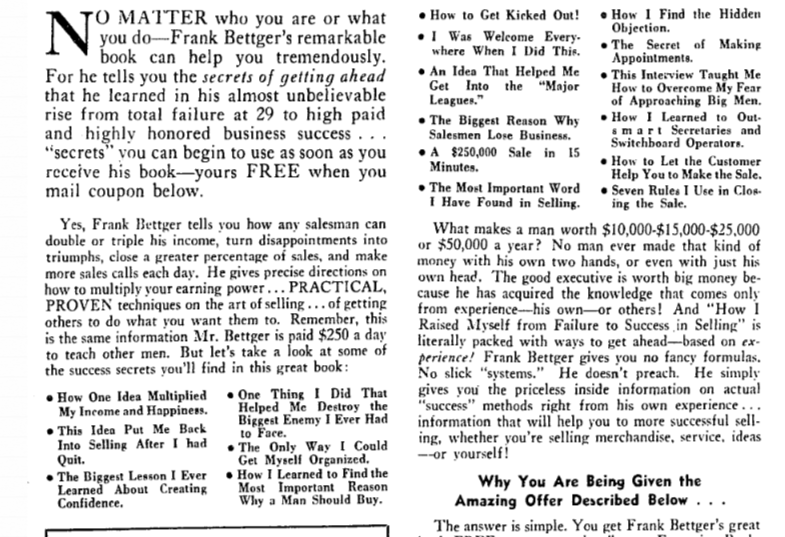
The first paragraph makes the reader's reward very clear and tells you what the product will do for you: It will give you the secrets of getting ahead and becoming a high-paid and highly honored business success.
The main sales appeal is business advancement (success, reward for merit, better job) which involves more money, pride of accomplishment, and praise from others.
Here is how he ties up the advantages to the product (Frank Bettger’s book):
- It tells you how any salesman can double or triple his income.
- It gives precise directions on how to multiply your earnings power.
- Practical, proven techniques on the art of selling and of getting others to do what you want them to.
- It gives you priceless inside information on actual “success” methods right from his experience. Information that will help you to more successful selling.
All the bullet points in the copy highlight the success secrets you’ll find in the book.
Even the offer shows the advantage.
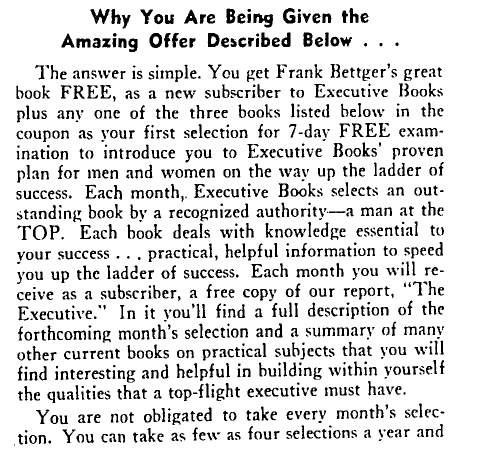
The ad promotes a subscription to Executive Books with a free gift (Frank Bettger’s book). The Executive Books subscription shows the advantages as follows:
- Each book deals with knowledge essential to your success.
- Practical, helpful information to speed up the ladder of success.
- Books you will find interesting and helpful in building within yourself the qualities that a top-flight executive must have.
Prove it
It's not enough to tell your readers what your product will do for them. Benefits and outcomes mean nothing if you don't prove that your product can deliver them.
Why it is important to prove it
There are two main reasons to introduce plenty of “prove it” facts into your sales copy.
1) Your reader's natural reaction is to discount your advertisement claims based on the following:
- The believability of your claims.
- The introduction of facts to prove those claims.
- The credibility of those facts.
2) People need and want facts as reasons and excuses for buying. They need to justify to themselves or others a decision to buy something based on emotions alone.
Before writing your copy, put all the facts together.
Do your research. Study the product, your customers and prospects, and your competitors. Try to identify facts that are familiar to your reader. They can increase believability because the reader recognizes them.
What kind of facts should you use as proof material?
To give you some ideas, here is a non-exhaustive list of facts:
- Facts about the materials used, the manufacturing process, the company (size, location, reputation, experience), and the founder (experience, skills).
- Facts about employees involved in the creation, installation, or promotion of the product.
- Facts about test results, material suppliers, patents, special processes used.
- Facts about the speed of delivery, packaging, and achievements of your product (endurance runs, mileage records, before-and-after images)
- Testimonial of experts (scientists, engineers, physicians, dietitians) who commend, or use, your product.
- Awards or contests won.
- Facts or figures proving consumer satisfaction.
- A guarantee demonstrating the manufacturer’s willingness to allow the quality of the product to speak for itself.
- Free samples of your product.
Make sure your facts are credible. Here are some ways to add credibility:
- Use claims that ring true. Sometimes, the actual truth may seem unbelievable to your reader. In those cases, you should tone it down.
- Not everything needs to be perfect. Admit your product faults.
“A little bad makes the good believable.” - Bernice Fitz-Gibbon.
- Make your facts specific. The more specific, the more convincing.
- Use actual photographs, rather than drawings, to increase credibility.
- Introduce clear, reasonable, and logical copy about why the promise can be performed.
- Make your advertisement more powerful by using “who says what” testimonials. Avoid testimonials that sound artificial or show excessive enthusiasm. Retain the sincerity, the awkward grammar, the colloquialism. If possible, use the full name and a photograph.
Victor's ad How to Win Friends and Influence People (Dale Carnegie) is a good example of using proof material throughout the copy.
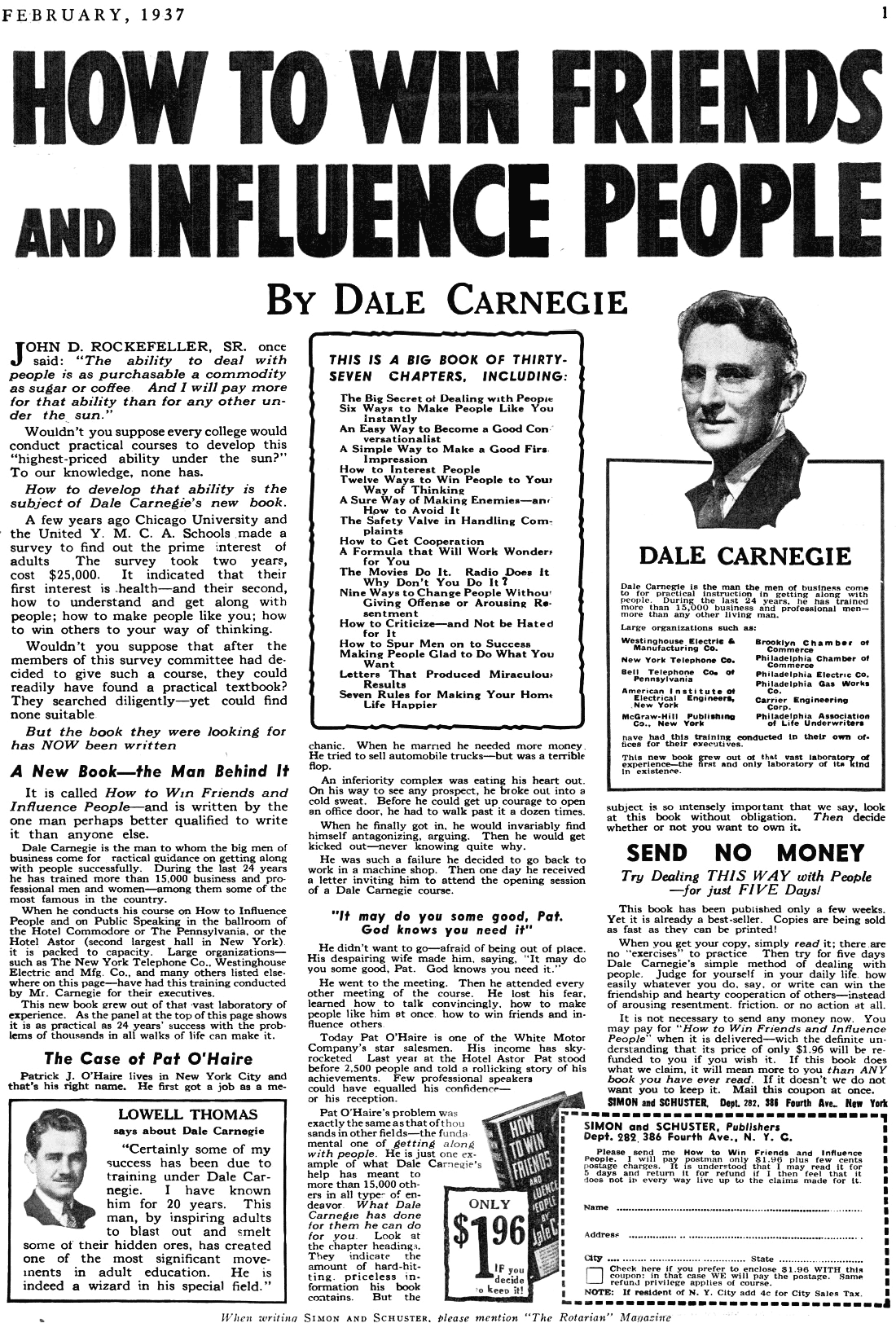
The ad starts by quoting John D. Rockefeller on the importance of the ability to deal with people. It's so important that "I will pay more for that ability than for any other under the sun", he says.
Coming from a business magnate, the reader immediately knows this ability is a must-have. It's proof that learning to develop this ability is something the readers need to do. It so happens to be the subject of Dale Carneige's new book.
The ad presents proof after proof. I'll not go over all of them but here you have some:
- The results of a survey that took two years and cost $25,000. It puts how to win friends and influence people as the second interest of adults, health being the first.
- Dale Carnegie is the man to whom big men of business come for practical guidance and getting along with people successfully.
- The case of Pat O'Haire who was incapable of getting along with people until he attended Dale Carneige's course.
- During the last 24 years, Dale has trained more than 15,000 business and professional men and women.
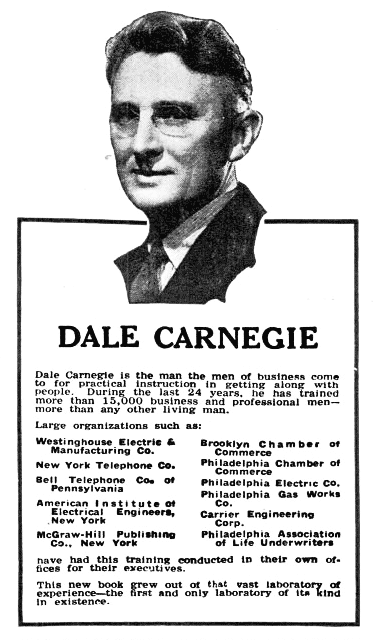

How to present your facts
Introduce proof material into any part of your promotion, from headline to close. There's no specific place to present proof. It should be used throughout your copy.
Things you can do:
- Dramatize your facts.
- Present your facts from the customer’s point of view. Translate technical specifications into human-interest proof that demonstrates what it will do for the reader.
- Be specific. Give details. Where were the product tests made? When? How? Where do the ingredients come from?
- Localize your testimonials whenever possible.
- Use “Performance Evidence” when possible. It shows the buyer what the product has actually done, rather than merely what it was built to do.
- If a reduced price is a fact, give a good reason for it. The reason is as important as the price itself.
Persuade People to Grasp This Advantage
This part is more of a summary. It closes the gap between your body copy and the action you want your reader to take.
It takes the claims and the proof and interweaves them into a strong conclusion. Its main purpose is to prepare the reader for the final step, Ask for Action.
Use this part to reiterate your strongest selling point, demonstrate a specific advantage of your product in use, show something unexpected, or use your most dramatic benefit.
In short copy, this part may be one or two sentences. In longer copy, it may be several paragraphs.
This part might have a tempo to encourage action:
- It’s more intense in style.
- It has a more emotional tone.
- It’s often more staccato with shorter sentences and a vigor of style.
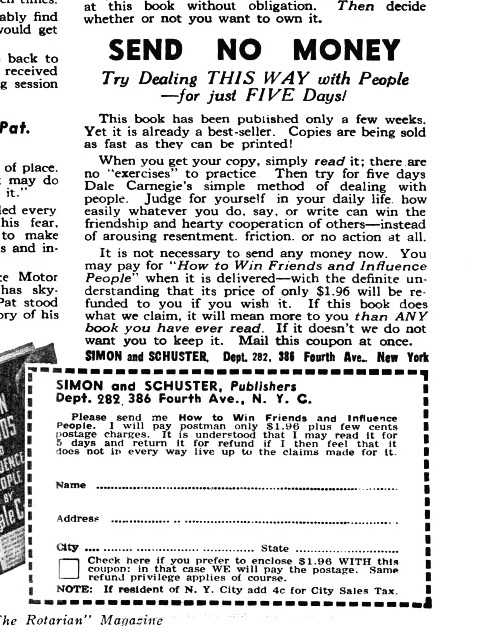
Ask For Action
You will be surprised how many times people forget to ask the reader to take a specific action.
For this part of your copy, ask yourself these two questions:
- “What do I want readers to do when they finish reading my copy?”
- “How, where, and when do I want them to do it?”
Make it simple, easy, and specific.
You also need to convince them to take action right away. There are several ways to do that:
- Make an offer. If your goal is to capture leads, offer some kind of lead magnet (ebook, mini-course, checklist, cheat sheet). Or offer a trial, a consultation, or a demonstration of the product.
- Use urgency and scarcity. Time limit to access the offer or a limited supply of the product.
- Price going up or down. Both can motivate the reader to take action right away.
- Gain or loss. Emphasize once again what your reader gains by buying now or what he loses by not having the product.
- Use a strong guarantee. Having a strong guarantee minimizes the risk of taking action.
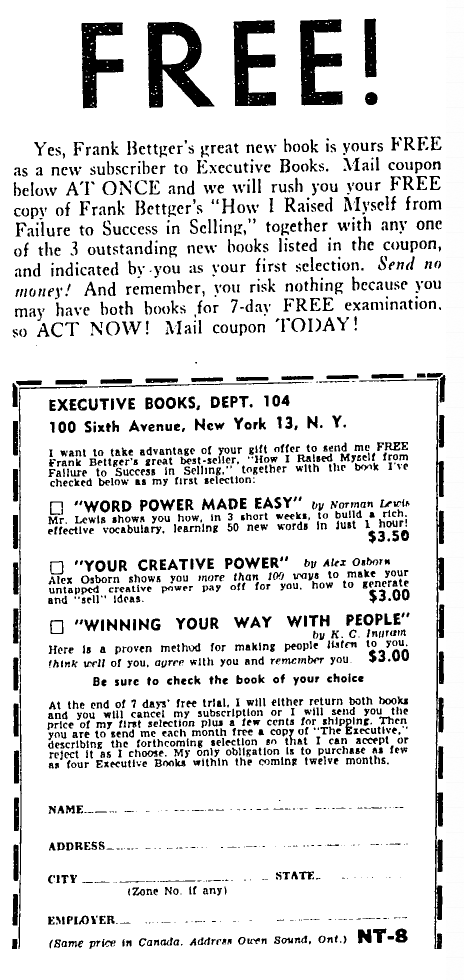
Let's recap the steps of the AAPPA formula.
- Get Attention. With your headline or your layout. Preferably with both. Select the right audience for your copy and promise them a reward for reading your copy.
- Show People an Advantage. The purpose of the second part of the formula is to answer this question, “What will your product DO for me?”
Tell your prospects what is in it for them. Show them an advantage throughout the body copy. The best place to start showing an advantage is your first paragraph. - Prove It. Benefits and outcomes mean nothing if you don't prove that your product can deliver them. Introduce credible facts to prove your claims.
- Persuade People to Grasp This Advantage. Takes the claims and the proof and interweaves them into a strong conclusion. Its main purpose is to prepare the reader for the final step, Ask for Action.
- Ask For Action. Ask the reader to take a specific action. Make it simple, easy, and specific, and convince them to take action right away.
Even though you can use the AAPPA formula to write any promotion, it works best on long-form sales pages or products and services that need to back up their claims with plenty of proof.
